Outlander proves Mitsubishi is alive and well
Filed under: Weekly test drives, Autos, Uncategorized
By John Gilbert
It seemed like it took most of a year before I got a chance to test drive a 2022 Mitsubishi Outlander SUV, and it was as much a relief to get one from Mitsubishi’s Midwest test fleet as it was to drive the midsize vehicle with what to me is a familiar name.
The Outlander has been completely redesigned, with a new platform and new engine and interior, to go along with the smaller Outlander Sport, and the even more-compact Eclipse Cross. I had feared that Mitsubishi might decide to quit marketing its vehicles in the U.S. because of the stiff competition worldwide.
I am pleased to see a resurgence in Mitsubishi vehicles. When I started analyzing and writing about new cars back in the late 1960s, it was an exciting crossroads of the industry, with some awkward and outdated American cars indignantly trying to hold off the arrival of high-mileage and high-tech imports from Japan.
Honda, Toyota, Nissan, Mazda and Subaru were trying to find their way into the U.S. market. So was a very impressive conglomerate known as Mitsubishi, made an arbitrary decision to go with Chrysler Corporation to produce some of its subcompacts like the Dodge Colt, and an amazingly durable and dependable 3.0-liter V6 that Chrysler put into various cars such as their Caravan and Voyager minivans. Those minivans were about to take over the family marketplace, and those bullet-proof engines were a big reason for their success. We have friends who put well over 200,000 on them, then gave them to their kids for another 100,000 economical miles.
Mitsubishi also built a subcompact, known as the Mirage, which in the U.S. became Dodge Colts and Plymouth Champs. They were fun and quick, and delivered over 40 miles per gallon, while the minivans were proving bulletproof.
I road-raced a Dodge Colt in the Sports Car Club of America’s new Showroom Stock category for that summer of 1970, using a Colt set up by White Bear Dodge for amateur competition. I learned a lot about road-racing when I battled a veteran driver and beat him for second place in a timed race around Donnybrooke Speedway’s 3-mile course, after which I was flattered to get the award for fastest race lap. Only then did it occur to me that if I turned the fastest lap, why was I fighting for socond instead of first?
I was impressed enough with Mitsubishi’s engineering that we bought a Colt station wagon for our young family, and later a Colt hatchback, on which y0u could screech the tires in the first three gears and still get 43 miles per gallon. As years passed, I also learned that Mitsubishi built the best electronics in the industry through its MGA televisions, tuners and speaker systems, and we enlisted in them, too.
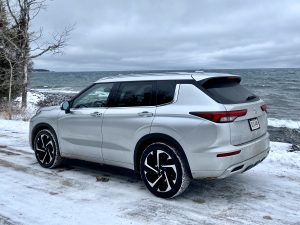
Outlander is reinforced as the iconic top model for Mitsubishi, with even a tight third row of seats.
The arrangement dissolved as Chrysler wound up being bounced around by various investor-owners, and stand-alone Mitsubishi dealerships faded and disappeared from a lot of cities, including Duluth, Minnesota, where we now live, and where a thriving dealership was eliminated and consumers had to search the Twin Cities to find a Mitsubishi dealership.
So the 2022 Outlander carries Mitsubishi’s hopes of expanding its reach in the U.S.,, and reports have been positive. Our test Outlander carried a sticker price of $35,295, which puts it right among its competition, although the Outlander was filled with feature options.
The similarity of cars and SUVs these days is such that many of them look alike, and to stand out means to incorporate some unusual styling. The Outlander has done just that, with a prominent grille outlined at the top by sleek, thin LED lights, which curve artfully around to outline the upper grille and descend to also isolate the small blocks of LED lights on either side of the lower grille. The lights themselves are outstanding, as well as certainly distinctive.
Surprisingly, for such a blunt compact, there is actually a third row seat, which must have required a masterstroke of engineering just to wedge it in back there. We never folded the seat up, choosing to leave it down in case we had a large supply of groceries. Maybe that’s perfect, because if you need to seat seven, two or them will have to be small children, who would love to have their own kid-size seats.
As the old saying goes, better to have it and not need it than to need it and not have it.
From the side, or rear, the Outlander’s graceful lines are more conventional, which is fine because its identity is in its face. Inside, the white quilted leather seats are encapsulating, and the shifter meets what seems to have become an obligatory complexity in simply moving your choice from park to drive or neutral or reverse. In the Outlander, it is less obtrusive and you learn to rock your finger fore or aft to find your desired gear. There is a large information screen mounted nice and high in the center of the dash, and you can find more information than an ordinary driver can want.
Under the hood, Mitsubishi has installed its new 4-cylinder engine, measuring 2.5 liters in displacement with a nicely balanced 181 horsepower and identical figure for torque, which collaborate to make the Outlander quick enough and sporty enough for a family hauler. It is annoying to try to find a CVT (continuously variable transmission) that is anything but boring, but in the Outlander, large paddles on either side of the steering wheel allow you to shift through eight stops on the CVT, and if you use the paddles adroitly, you can forget you even have a CVT in the thing.
Some have accused the Outlander of leaning too far on turns, but I found it just right — better than an overstuffed vehicle but tastefully short of being racy. The EPA estimates show 24 miles per gallon city and 30 in highway driving, and we got 32 or 33 on combined but mostly city driving. Our gauge showed 32.6, for example.
It’s also evident that Mitsubishi is heading toward hybrid and electric power, and I await any plans that may be coming.
Mitsubishi maintains the tradition of offering something beyond the normal technology, and an example might be that instead of just calling it “all-wheel-drive,” the Outlander’s system is called “Super All-Wheel Control.” There are some creative ways of executing, with adjustments for setting your drive mode.
We did some experimenting on some hard ice to see exactly what difference the change in modes might make. With my son, Jack, standing outside the car to observe me on a slab of ice, I tried accelerating hard in normal, and in the slippery setting. In normal, all four wheels spun immediately in chorus; in slippery, the front wheels spun for a couple revolutions, and after a momentary delay the rear ones started to spin, too.
In overview, the new Outlander lives up to its redesign scheme by looking unique, and it lives up to Mitsubishi’s reputation of adding a few new wrinkle to the drivetrain and shifting process. It passes all the tests for comfort and economic efficiency as well, and its audio system is as good as anticipated.
For me, of course, it’s also a tremendous benefit just to know Mitsubishi is still selling vehicles in the U.S. and its positive sales since the Outlander’s redesign mean good things for the future.
Bronco versatility includes 2-door, stick shift
Filed under: Weekly test drives, Autos, Uncategorized
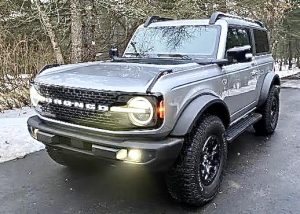
Larger than the Bronco Sport, the “regular” Bronco is roomier, more rugged, and has a 2-door version.
By John Gilbert
Auto companies can baffle us with the manipulation of introductions, and the most recent example is the highly popular Ford Bronco, which revives the name of the company’s original SUV workhorse, loaded up with modern technology. If I didn’t know better, I might have thought Ford created more questions than it answered when it brought out a string of the versatile and useful Bronco, although I enjoyed all the different versions I drove.
How could you not enjoy the Bronco Sport, a tight little 4-door SUV capable of handling all your objectives for family SUV duties or light off-roading? And then I got a second one, also a Bronco Sport, and also fun to operate. And later still, I got one with a stick shift that was a bit more work/off-road oriented, with a slick-shifting 7-speed manual. After all that, I got the bigger Bronco, not the Bronco Sport, and in 2-door fashion.
I knew that Ford also was bringing out a larger Bronco a bit later than the Bronco Sport, with more interior room, and the ability to haul more people and stuff. So about the time I figured out the 4-door Bronco, I got a couple different 2-door models, and they also were fun to drive, and felt sportier.
If you aren’t slightly confused by now, maybe you haven’t been paying close attention. I eagerly hopped into the most recent Bronco, realizing immediately something was different. That was because it was a 2-door, after all the earlier ones of both were 4-doors.
The 4-door is well made and takes care of business efficiently. But, c’mon — don’t we all harbor secret fantasies about having a 2-door SUV? I know I have.
The first 2-door model I had was the stick shift! Ford has equipped some Broncos with a 7-speed stick, and that gives you the ability to keep it right where you want it no matter what your intentions are. Fortunately, the second one I got came equipped with the 10-speed automatic, a smooth-shifting unit that is perfectly set up for the equipment at hand and offered a comparison.
The Bronco 2-door Advanced 4X4 was the “Black Diamond” model and felt light and quick, and came with a 2.3-liter EcoBoost twin turbocharged 4-cylinder engine. The stick was remarkably smooth to shift and accelerated out of trouble with ease. It has 275 horsepower and 315 foot-pounds of torque.
The hill-start assist is a neat feature, with a stick, because it puts you at ease when you stop on a hill, sure that the vehicle won’t start rolling backward while you’re heel-and-toeing at a stoplight short of the crest.
That’s particularly handy if you’ve gotten a little rusty in your heel-and-toe skills with a stick and a clutch. It also had what Ford calls “full vehicle steel bash plates.”
The 2-door gives you a spacious rear seat, although getting into it requires some agility.
The Black Diamond trim is neat and gives you some dded features, including an optional removable roof. Ford wants the Bronco to tackle the same off-road projects as the Jeep Wrangler, so it starts out by making it available with doors that pop off, in addition to the roof, so you can go cavorting around doorless and topless, if that suits you. Also in the concept of stripping it down for hardy use, the side mirrors come affixed to the frame itself, rather than on the door, which always seems to cause more vibration and need for adjustment. No adjustment needed, in this case, even if the doors are back home in the garage.
The Bronco 2-door with the 10-speed automatic was equipped with the Wildtrak package, which means, in my tester’s case, a 2.7-liter EcoBoost V6, with lots of excessive power, compared to the 2.3-liter 4. The V6 lists 315 horsepower and 410 foot-pounds of torque, at a sticker price of $53,650.
Curiously, the larger engine with the automatic didn’t feel as quick as the four with the stick.
One of the features that attracts folks to the Bronco is the array of gadgets that make it seem like a good deal, such as the cargo area protectors, the black roof rails, and the neat LED headlights that shine in a tight pattern even though appeareing to be squinting just a bit. The heavy duty floormats can be hosed off for cleaning if your off-roading includes acquiring a bit of mud inside and out.
When I first saw the array of Broncos, I wasn’t sure where I stood. But the stick-shift 2.3-liter version lists for $42,720, as equipped, while the 2.7 V6 model lists for $53,650. Both have distinct personalities, after you realize there are some differences.
The smaller Bronco Sport, with four doors, makes any selection a tough choice. Among the impressive advancements in modern cars is that some of the new 4s perform right up there with the usual V6es, and some of the new automatics seem to work as efficiently as the best stick shifts. Such modern automatics work so smoothly that they can relegate the stick shifts to the discard pile. Unless, that is, you like stick shifts as much as I do.
In the case of the Bronco family, the stick can make the 4-cylinder feel quicker and deliver better fuel economy than the V6. In that manner, the stick makes the 4-cylinder function like old-time off-roaders, even ones originally called Broncos.
That is especially so if you take the doors off and let it all hang out, so to speak.
4Runner adds loaded TRD Sport
Filed under: Weekly test drives, Autos
By John Gilbert
For nearly 40 years, Toyota has been building a midsize SUV known to the world as the 4Runner. Great name, because while it may not have been as all-out off-road-capable as the Jeep, its name alone means it is verifiably “the” 4Runner.
Every manufacturer of SUVs wants to take a shot at the Jeep’s incredible off-road heritage, even those that do a reasonable job of but light off-roading, fall far short of those Wranglers and other members of the Jeep family. But the 4Runner is different, and the 2022 version of the 4Runner — part of the fifth generation — lets its performance and reputation carry it beyond where mere public relations might go.
If you talk to a Toyota dealer, you might get its salesmen to agree with you that there isn’t a great deal of new stuff on the 4Runner. But ask him which vehicle is in the greatest demand among all things Toyota, and he might say the 4Runner. And in the same breath, if he knows his business, he might tell you the 4Runner will climb mountains and challenge any terrain the Jeep Wrangler will take on, and not finish second.
We can’t verify that, but the new 4Runner is impressively equipped for rugged duty and it is designed to stand the test of time, and it is not just another body-on-frame truck. The other fact in 4Runner’s favor is that while the new models may seem expensive, they hold their value so well that demand for two or three year old 4Runners is off the scale. A Toyota salesman I know said buyers seeking recent-year used 4Runners is right up there with the Tacoma midsize pickups on which it is based, and the full-size Tundra pickups.
The new 4Runner now can offer seating for seven, and it comes in over a half-dozen varieties. The model I test drove was the “TRD Sport,” a newcomer to the family.
If you list the 4Runners, you start with the SR5, SR5 Premium, TRD Off-Road, TRD Off-Road Premium, and the Limited Pro, and the Special Edition. That’s six, and adding the TRD Sport borrows from some of its siblings in expanding the brand to provide pretty much the specific vehicle anyone might want.
The TRD Off-Road is the most rugged, probably, and it has seriously upgraded suspension and suspension, with the Premium version getting the cross-pattern adjustable suspension, which adjusts the suspension in a cross pattern — left front-right rear or right front-left rear — to offer better cornering and off-road stability. The TRD Off-Road Premium has that, and that alone gives the new TRD Sport something beyond the scoops and specialty logos and badges and special seat surfaces to justify its price tag of the tester’s $48,199.
Painted “Magnetic Gray,” the TRD Sport has a base price of $44,620, and adding in such things as th kinetic dynamic suspension system, running boards and the moonroof jacks the price.
As seems to be the case in virtually all new vehicles these days, less is said about the powertrain, which used to be the main focal point of promotion. In the 4Runner, you get Toyota’s 4.0-liter V6, which delivers 270 horsepower, and 278 foot-pounds of torque, which is certainly enough to climb your neighborhood avenue, if not cliff. And it also will tow a maximum of 5,000 pounds.
Transmission is a 5-speed automatic, operable with paddles for manual control, and with a part-time 4-wheel-drive system and Toyota’s ActivTRAC, it seems as though five gears are enough, since you can double them by shifting back and forth from 2-wheel to 4-wheel drive, and choose high or low ranges.
We found that we pretty well matched the EPA fuel economy figures of 16 city and 19 highway miles per gallon, which is OK for a rugged vehicle that has such consumer-aided assets, although a lot of competitors will get from 25 miles per gallon and upward toward 30. Maybe it’s just a matter of time until Toyota bolts one of its hybrid systems into it.
If Toyota has been subtle about toughening the 4Runner for all off-road capabilities, now it is just as subtle about sophisticating the whole package to work more smoothly and be more civilized on normal roads. Those are the assets the refinements make on the TRD Sport, and the comfort inside is evidence that it works. The seats are covered with SofTex, which is some sort of bullet-proof material that is pleasing to the touch and obviously rugged.
It was just a matter of luck that in the week I had the 4Runner TRD Sport, my Duluth-area was hit by a pretty healthy snowstorm, which meant I could fiddle around with the settings and churn through the plow-left snow-piles with ease.
If you are a serious off-roader, this TRD Sport would work well, and if you’re not into off-roading, you can actually enjoy spending your winter months taking on blizzards and foul-weather conditions. It is also fascinating to observe the new Jeep Grand Cherokee go from being off-road tough to on-road sophisticated, but even there, the Toyota 4Runner TRD Sport gives that brand an equal competitive stance either on or off the road.


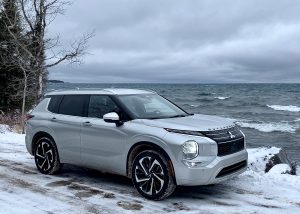

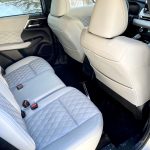
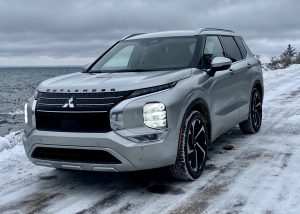
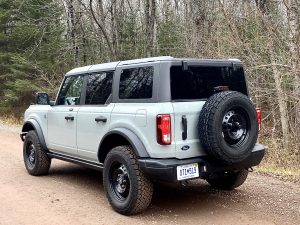
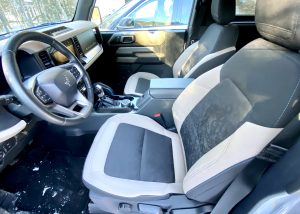
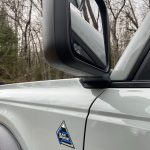
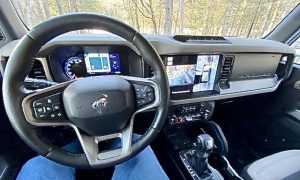
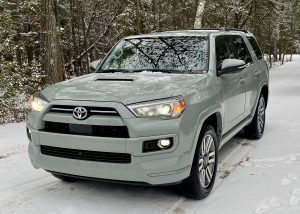
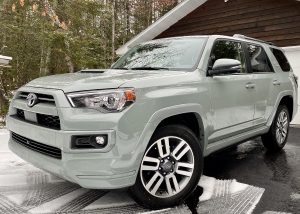
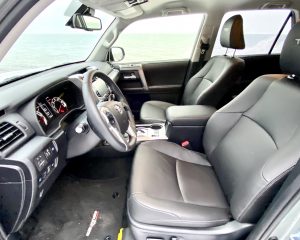
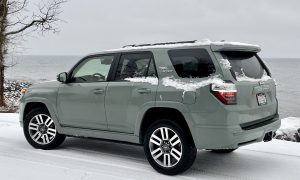
 John Gilbert is a lifetime Minnesotan and career journalist, specializing in cars and sports during and since spending 30 years at the Minneapolis Tribune, now the Star Tribune. More recently, he has continued translating the high-tech world of autos and sharing his passionate insights as a freelance writer/photographer/broadcaster. A member of the prestigious North American Car and Truck of the Year jury since 1993. John can be heard Monday-Friday from 9-11am on 610 KDAL(www.kdal610.com) on the "John Gilbert Show," and writes a column in the Duluth Reader.
John Gilbert is a lifetime Minnesotan and career journalist, specializing in cars and sports during and since spending 30 years at the Minneapolis Tribune, now the Star Tribune. More recently, he has continued translating the high-tech world of autos and sharing his passionate insights as a freelance writer/photographer/broadcaster. A member of the prestigious North American Car and Truck of the Year jury since 1993. John can be heard Monday-Friday from 9-11am on 610 KDAL(www.kdal610.com) on the "John Gilbert Show," and writes a column in the Duluth Reader.